Experimental Study of the Relaxation Properties of Carbon Fiber Cloth
Abstract
1. Introduction
2. Test Overview
2.1. Specimen Parameters and Material Mechanical Properties
2.2. Test Loading Method
2.3. Test Measuring Method
3. Test Results and Analysis
3.1. Stress Loss Analysis
3.2. Effect of Prestress Level on Relaxation Loss
- (1)
- At the beginning of the test, the magnitude of stress relaxation of the CFRP fabric increased rapidly, and the relaxation rate raised promptly too. A shown in Figure 7a,c,e, the uncoated specimens could reach more than 85% of the final relaxation rate of the whole test period (168 h) just after 24 h. Figure 7b,d,f shows that, after 24 h, the glue-coated specimens could reach more than 95% of the final relaxation rate of 168 h. Thereafter, the relaxation rate gradually grew and ultimately tended to become stable.
- (2)
- It can be found that, when the relaxation rate was increased from 0.1 to 0.3 fu, the prestress level of the test pieces of the three groups decreased significantly. When the prestress level was increased to 0.34 fu, the decrease in the relaxation rate was reduced substantially. We argue that this was because, when the prestress level was between 0.1 and 0.3 fu, as the prestress level increased, the curved fibers in the specimens became straightened, and the performance of the fiber cloth was improved. The larger is the prestress level, the more obvious this improvement will be. Hence, the relaxation rate raised with the prestress. When the prestress level was increased to 0.34 fu, some of the shorter fibers in the fiber cloth were broken resulting in the reduction of the performance of the fiber cloth. At this time, if the prestress level was raised further, the working performance of the fiber cloth not only did not increase but also decreased. Therefore, the relaxation rate of the specimen grew continuously with the increase of the prestress level.
3.3. Effect of Specimen Length on Relaxation Loss
3.4. Results Analysis of the Glue-Coated Test Pieces
3.5. Relaxation Rate-Time History at Different Positions of Carbon Fiber Cloth
4. Calculation of Relaxation Rate
4.1. Shortcomings of Existing Relaxation Rate Equations
4.2. A New Relaxation Rate Equation
5. Comparison of Calculated and Experimental Results
5.1. Comparison of the Calculated Values of the Relaxation Rate with Those of the Experimental Results
5.2. Comparison of Different Tests Results
6. Conclusions
- (1)
- The relaxation rate of CFRP cloth was between 1.92% and 6.1%.
- (2)
- After 24 h, the relaxation rate of CFRP cloth could reach more than 85% of the final relaxation rate of the whole test time (168 h). When the prestress level was less than 0.3 fu, the curved fibers in the CFRP cloth were straightened so that the performance of the CFRP cloth was fully enhanced and the relaxation rate decreased when the prestress level was increased. When the prestress level was greater than 0.3 fu, some fibers were broken. Thus, the stress redistribution occurred, and the relaxation rate increased as the prestress level was increased.
- (3)
- As the size of CFRP fabric increased, defects such as insufficient straightness and short length caused during the fabrication process raised the stress loss. It was observed that, at the same prestress level, the relaxation rate decreased by a maximum of 47.6%.
- (4)
- The relaxation loss was reduced by gluing of the test piece, and the relaxation rate was also diminished by 3.11–5.89% due to gluing. After the gluing treatment, the fiber cloth was evenly stressed, and the shorter fibers were not broken due to uneven stress. Hence, fiber cloth integrity was improved. In engineering practice, the size of the fiber cloth should be appropriately increased, and the pre-stress level should also be increased. In addition, the surface of the fiber cloth should be coated with glue to reduce the relaxation loss and to increase the effective prestress, which is advantageous for enhancing the reinforcement effect.
- (5)
- According to the test results analysis, there were gaps between the sole carbon fabric after the prestress was applied. Moreover, there was a certain loss during the stress transmission process which made the CFRP cloth end stress greater and the middle stress smaller.
- (6)
- The results of the equation established in this research can be used to predict the relaxation rate of CFRP cloth. These results were in good agreement with the experimental results. The deviation of the predicted results from the experimental results existing in the literature was small and the degree of dispersion was minor too. Therefore, the new equation proposed in this study can effectively predict the relaxation rate of the CFRP cloth.
Author Contributions
Funding
Conflicts of Interest
Nomenclature
| AV | Average value |
| COV | Coefficient of variation |
| E | Modulus of elasticity of materials |
| Tensile strength of materials | |
| compressive strength of materials | |
| Ultimate strength of materials | |
| L | Tensile length of specimen |
| SD | Standard deviation |
| Prestress level of CFRP | |
| The slippage between the CFRP and the anchor end | |
| Control tension stress of the CFRP cloth | |
| Eliminate loss of stress caused by relaxation, effective stress, | |
| Measured stress loss of the CFRP cloth | |
| Stress of the relaxation loss of the CFRP cloth | |
| Stress loss of the CFRP cloth caused by the slippage between the CFRP and the anchor end | |
| Stress of the relaxation loss of the CFRP cloth in 24 h | |
| Stress of the relaxation loss of the CFRP cloth in 100 h | |
| Stress of the relaxation loss of the CFRP cloth in 168 h | |
| Relaxation rate of the CFRP cloth | |
| Test relaxation rate of the CFRP cloth | |
| Calculate relaxation rate of the CFRP cloth | |
| Relaxation rate of glue application specimen | |
| Relaxation rate of unglue application specimen |
References
- Cai, H.W.; Aref, A.J. On the design and optimization of hybrid carbon fiber reinforced polymer-steel cable system for cable-stayed bridges. Compos. Part B Eng. 2015, 68, 146–152. [Google Scholar] [CrossRef]
- D’Antino, T.; Pellegrino, C. Bond between FRP composites and concrete: Assessment of design procedures and analytical models. Compos. Part B Eng. 2014, 60, 440–456. [Google Scholar] [CrossRef]
- Elrefai, A.; West, J.S.; Soudki, K. Performance of CFRP tendon-anchor assembly under fatigue loading. Compos. Struct 2007, 80, 352–360. [Google Scholar] [CrossRef]
- Faleh, H.; Al-Mahaidi, R.; Shen, L.M. Fabrication and characterization of nano-particles-enhanced epoxy. Compos. Part B Eng. 2012, 43, 3076–3080. [Google Scholar] [CrossRef]
- Kim, D.J.; Lee, J.; Lee, Y.H. Effectiveness factor of strut-and-tie model for concrete deep beams reinforced with FRP rebars. Compos. Part B Eng. 2014, 56, 117–125. [Google Scholar] [CrossRef]
- Koo, J.M.; Choi, J.H.; Seok, C.S. Prediction of post-impact residual strength and fatigue characteristics after impact of CFRP composite structures. Compos. Part B Eng. 2014, 61, 300–306. [Google Scholar] [CrossRef]
- Mufti, A.A. FRPs and FOSs lead to innovation in Canadian civil engineering structures. Constr. Build. Mater. 2003, 17, 379–387. [Google Scholar] [CrossRef]
- Neto, P.; Alfaiate, J.; Vinagre, J. A three-dimensional analysis of CFRP–concrete bond behavior. Compos. Part B Eng. 2014, 59, 153–165. [Google Scholar] [CrossRef]
- Pham, T.M.; Hao, H. Impact Behavior of FRP-Strengthened RC Beams without Stirrups. J. Compos. Constr. 2016, 20, 04016011. [Google Scholar] [CrossRef]
- Hassan, R.; Youssef, O.; Mills, J. Seismic Performance of Precast Post-Tensioned Segment FRP-Confined and Unconfined Crumb Rubber Concrete. J. Compos. Constr. 2017, 21, 04017006. [Google Scholar] [CrossRef]
- Sundar, N.; Raghunath, P.N.; Dhinakaran, G. Flexural behavior of RC beams with hybrid FRP strengthening. Int. J. Civ. Eng. Technol. 2016, 7, 427–433. [Google Scholar]
- Raoof, S.M.; Koutras, L.N.; Bournas, D.A. Textile-reinforced mortar (TRM) versus fiber-reinforced polymers (FRP) in the flexural strengthening of RC beams. Constr. Build. Mater. 2017, 151, 279–291. [Google Scholar] [CrossRef]
- Lu, C.L.; Zhang, Z. Review on prestress lossof frp in reinforcement system. J/OL. Guilin Univ. Technol. 2020, 1–11. [Google Scholar]
- Saadatmanesh, H.; Tannous, F.E. Long-term behavior of aramid fiber reinforced plastic (AFRP) tendons. Aci. Mater. J. 1999, 96, 297–305. [Google Scholar]
- Tannous, F.E. Relaxation, creep, and fatigue behavior of carbon fiber reinforced plastic tendons. Aci. Mater. J. 1999, 96, 143–153. [Google Scholar]
- Gunnarsson, A. Bearing Capacity, Relaxation and Finite Element Simulation forPrestressed Concrete Beams Reinforced with BFRP Tendons. Master’s Thesis, Reykjavik University, Reykjavík, Iceland, 2013. [Google Scholar]
- Shi, J.; Wang, X.; Huang, H.; Wu, Z. Relaxation behavior of prestressing basalt fiber-reinforced polymer tendons considering anchorage slippage. J. Compos. Mater. 2016, 51, 1275–1284. [Google Scholar] [CrossRef]
- Guo, X.Y.; Zhong, M.J.; Jin, H.; Huang, P.Y. Experimental Study of Pre-stress Loss of RC Beam Strengthened by Pre-tensioned Pre-stressing CFL. J. Exp. Mech. 2016, 31, 141–148. [Google Scholar]
- Huang, J.; Huang, P.; Zheng, X. Experimental study of prestress losses of RC beams strengthened with prestress FRP. J. Build. Struct. 2015, 36, 85–91. [Google Scholar]
- Kim, Y.J.; Wight, R.G.; Green, M.F. Flexural Strengthening of RC Beams with Prestressed CFRP Sheets: Development of Nonmetallic Anchor Systems. J. Reinf. Plast. Compos. 2010, 29, 1277–1294. [Google Scholar] [CrossRef]
- Costa, I.; Barros, J. Prestress Losses in NSM-CFRP Flexurally Strengthened RC Beams. Strain 2015, 51, 276–287. [Google Scholar] [CrossRef]
- Zhou, C.; Li, J.; Zhu, W.; Yang, F. Design of Self-locking Anchor System of FRP and Research on Mechanical Properties. J. Build. Struct. 2013, 34, 141–148. [Google Scholar]
- Lu, C.L.; Liu, C.C.; Wu, Y.S.; Wang, P.; Li, Z.Y. Experimental study on prestress loss of concrete circular columns strengthened with prestress cfrp sheets. J. Highw. Transp. Res. Dev. 2018, 35, 41–48. [Google Scholar]
- Lu, C.L.; Wu, Y.S.; Wang, Q.; Liu, C.C.; Li, Z.Y. Experimental research on the prestressing loss of square concrete columns strengthened with prestressed cfrp sheets. Ind. Constr. 2017, 47, 41–46. [Google Scholar]
- Wang, W.W.; Dai, J.G.; Zhang, L. Study on prestress loss test and calculation method of reinforced concrete beams strengthened with post-tensioned CFRP sheets. Proc. Civ. Eng. 2012, 11, 88–94. [Google Scholar] [CrossRef]
- Wang, W.W.; Dai, J.G.; Harries, K.A.; Bao, Q.H. Prestress Losses and Flexural Behavior of Reinforced Concrete Beams Strengthened with Posttensioned CFRP Sheets. J. Compos. Constr. 2012, 16, 207–216. [Google Scholar] [CrossRef]
- Li, S.H. Construction technology for reinforced concrete beams strengthened with prestressed CFRP. Constr. Technol. 2004, 33, 60–62. [Google Scholar]
- Li, S.H. Experimental study on stress relaxation of carbon fiber cloth. Build. Struct. 2009, 4, 72–75. [Google Scholar]
- Deng, Z.C.; Li, J.H.; Zhang, J.J.; Niu, K.; Liu, C.G. Experimental study on stress relaxation of aramid fiber cloth. Build. Struct. 2008, 6, 110–112. [Google Scholar]
- Lu, C.L.; Wang, Q.; Wu, Y.S. A device for testing the stress relaxation of FRP cloth. China Patent CN205607767U, 28 September 2016. [Google Scholar]
- China Communications Press. JTG 3362-2018 Code for Design of Highway Reinforced Concrete and Prestressed Concrete Bridges and Culverts; China Communications Press: Beijing, China, 2018. [Google Scholar]
- American Association of State Highway and Transportation Officials. LRFD Bridge Design Specifications; American Association of State Highway and Transportation Officials: Washington, WA, USA, 2005. [Google Scholar]
- Wu, Y.S. Experimental Study on Prestress Loss of Concrete Columns Strengthened with Prestressed CFRP Sheets. Master’s Theses, Gui Lin University of Technology, Guilin, China, 2017. [Google Scholar]
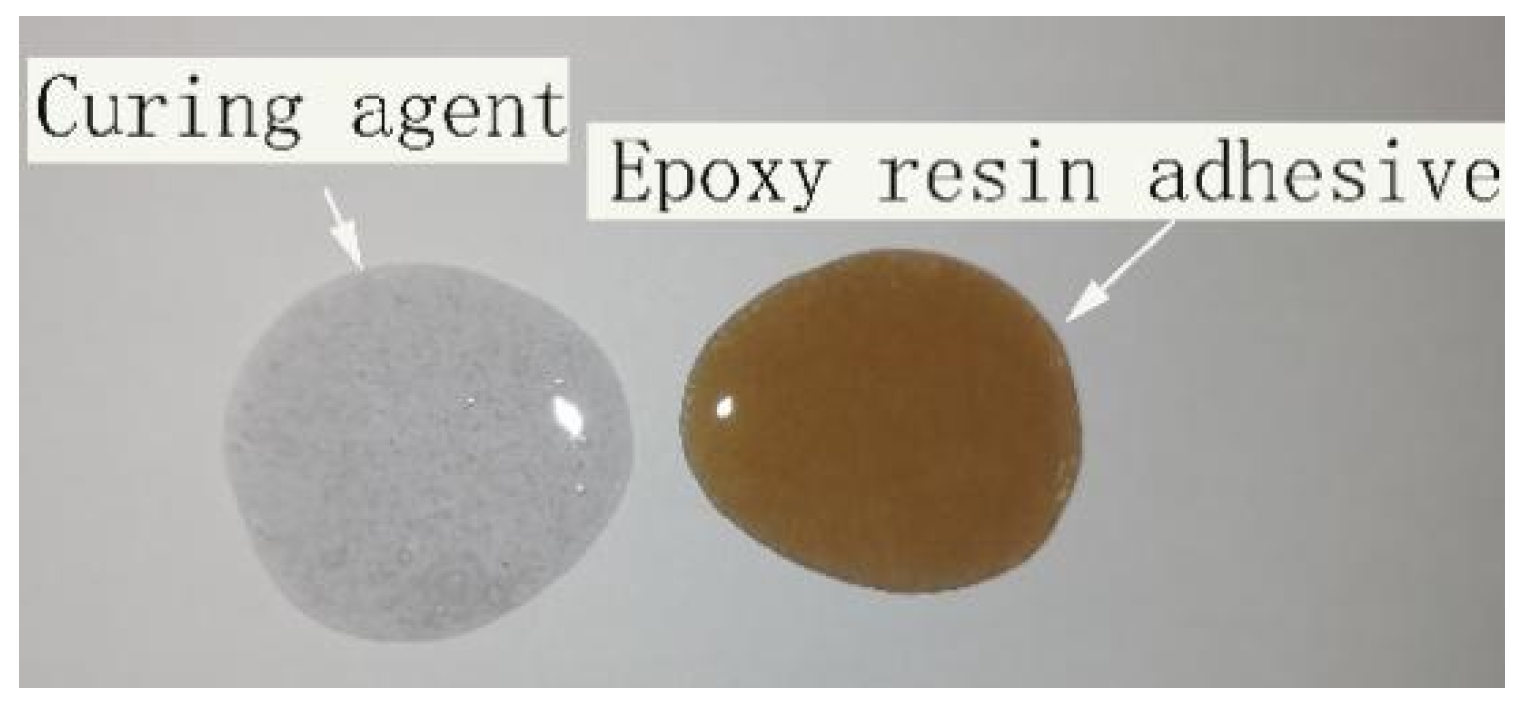
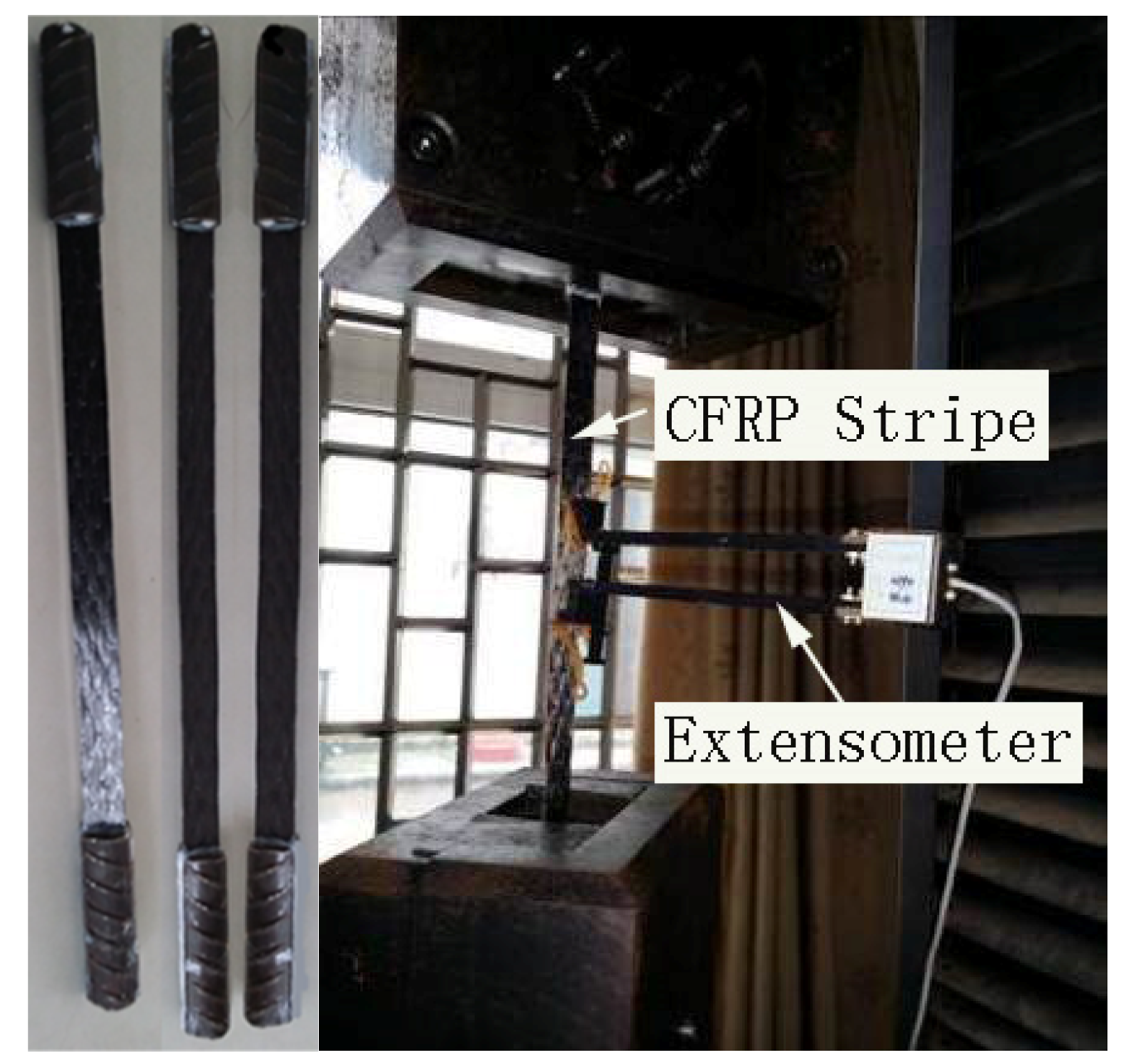
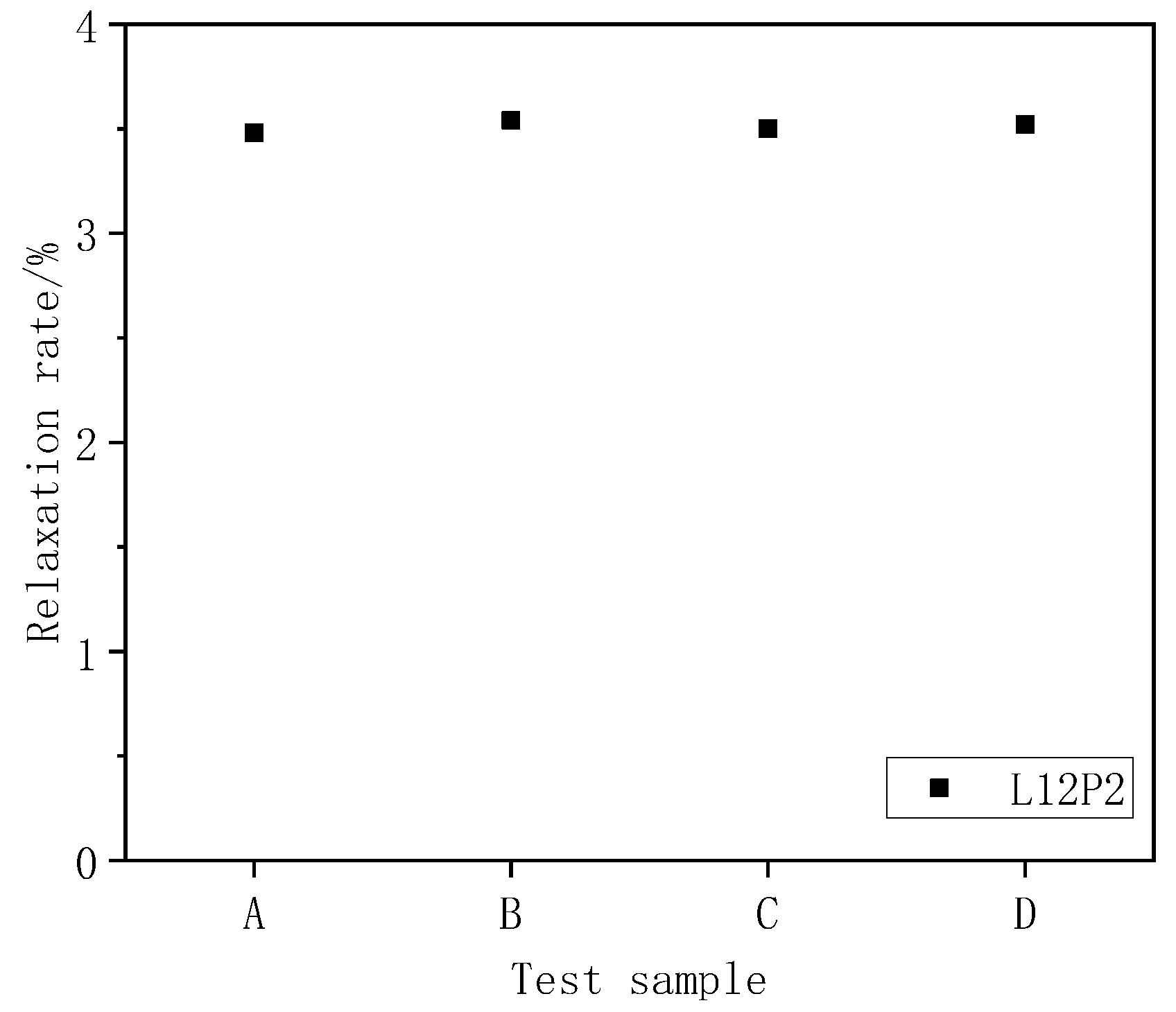
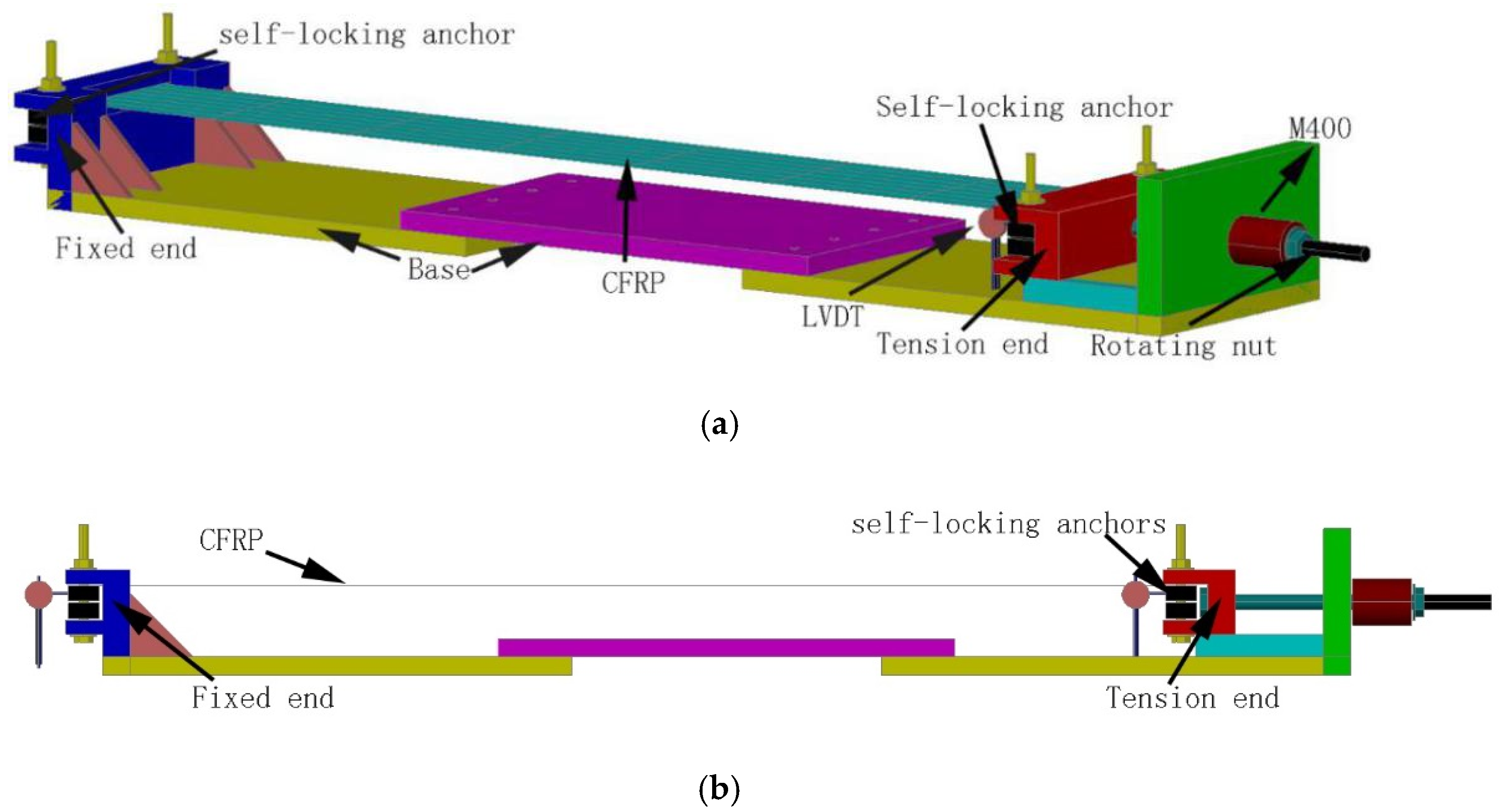
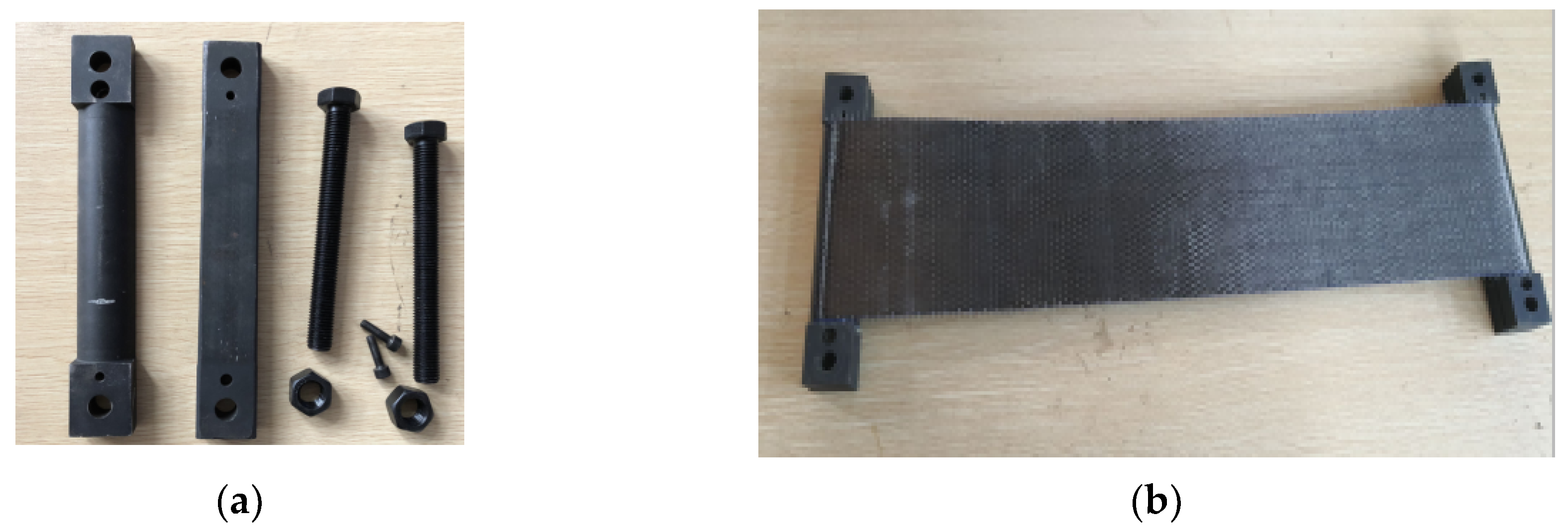
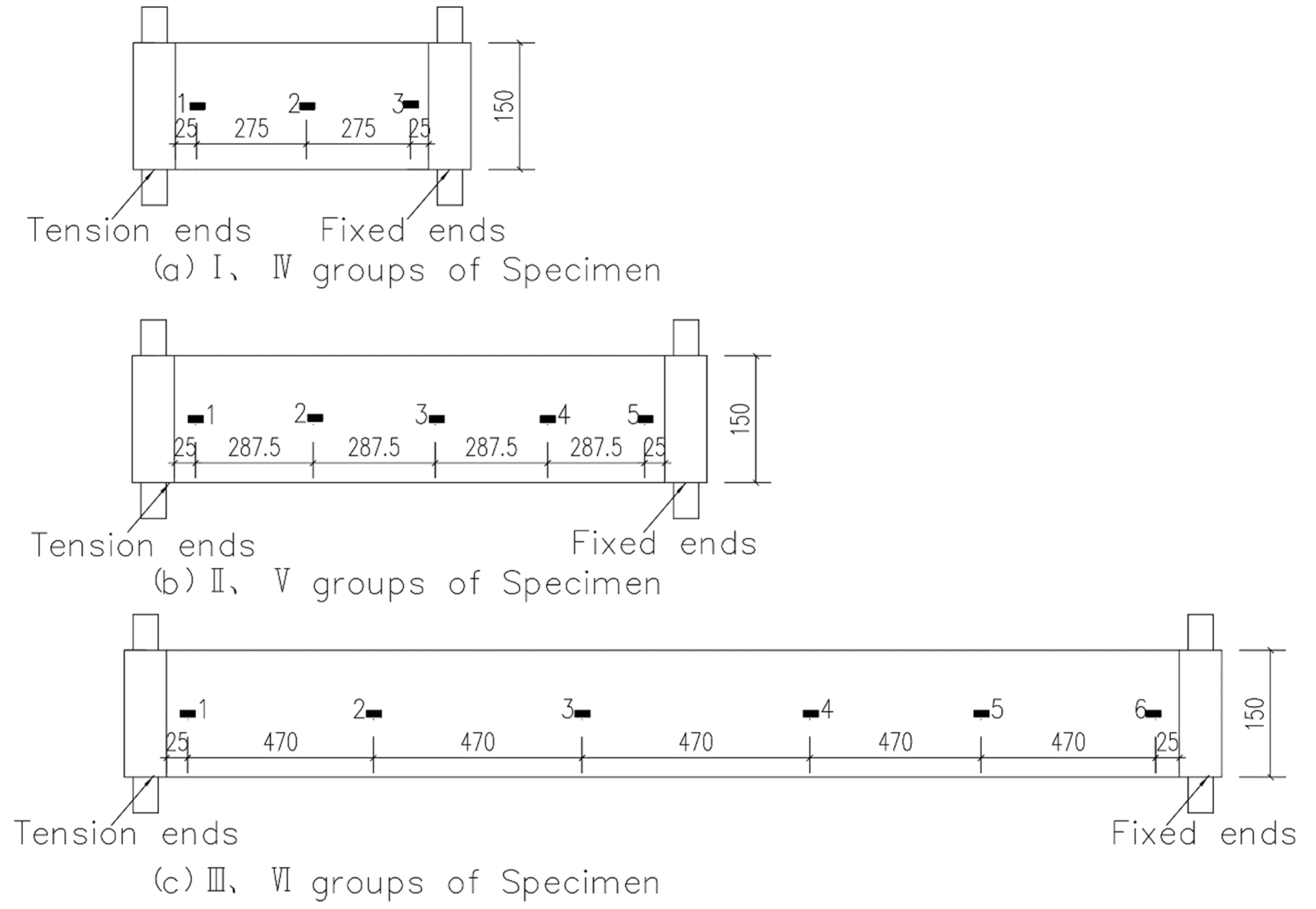
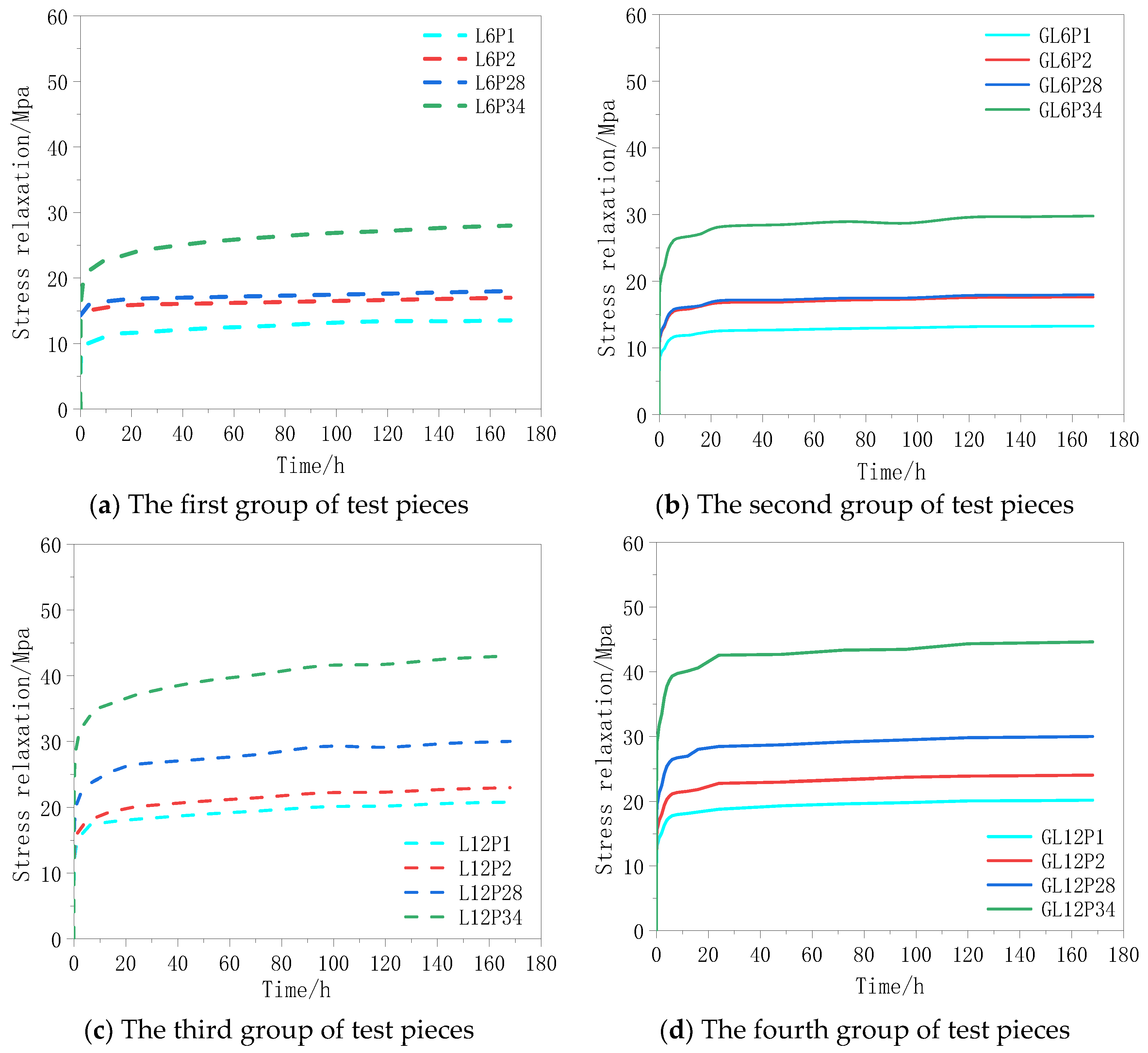
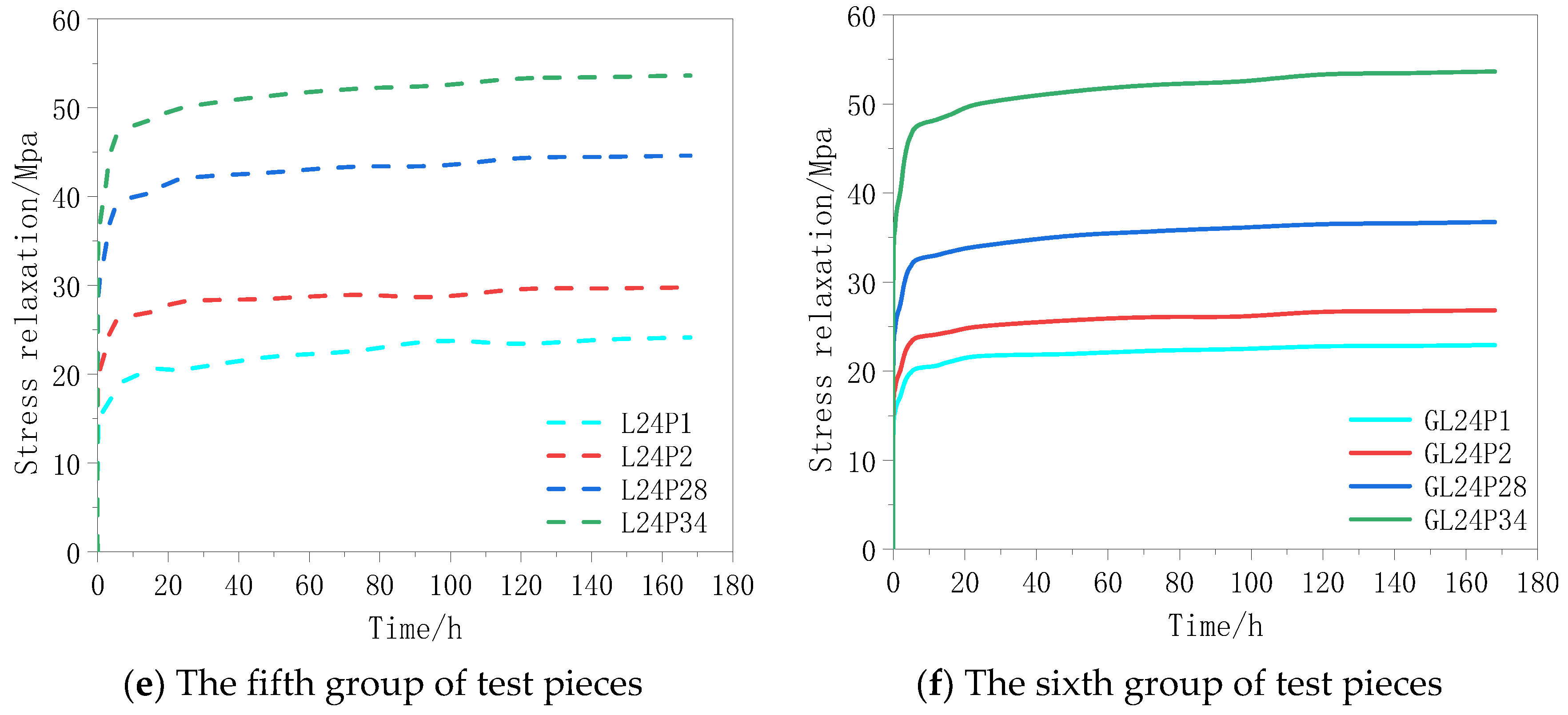
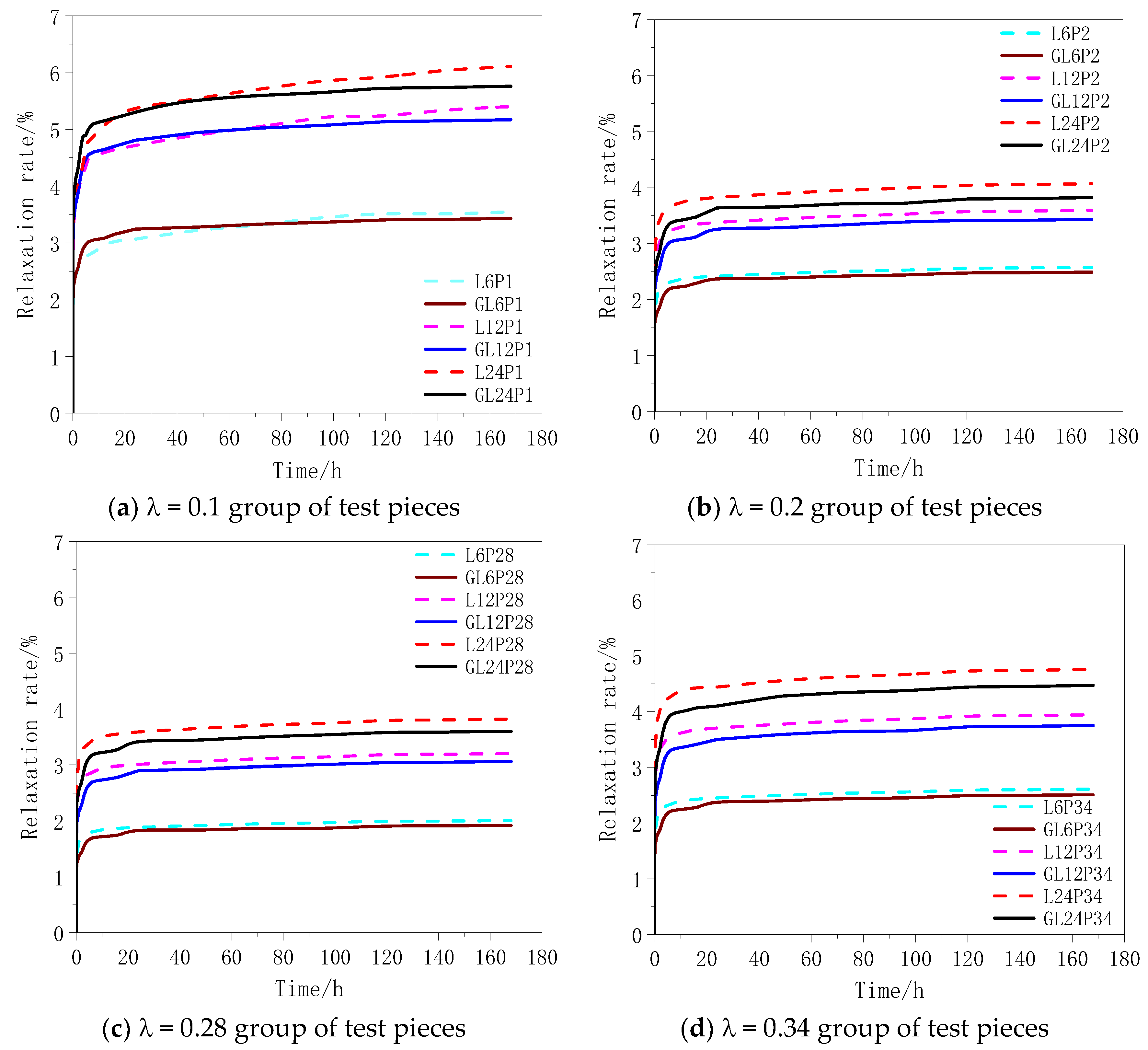
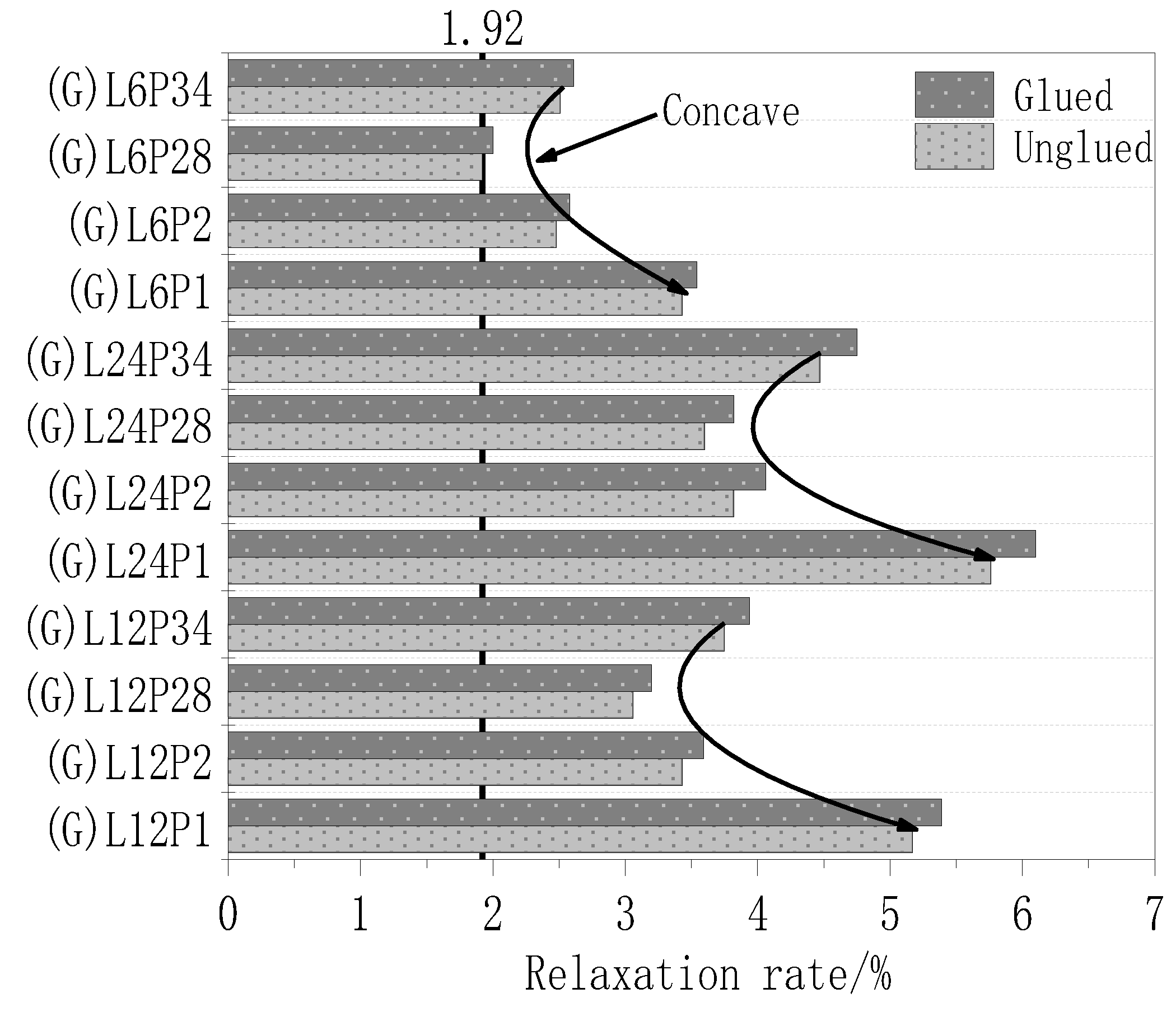
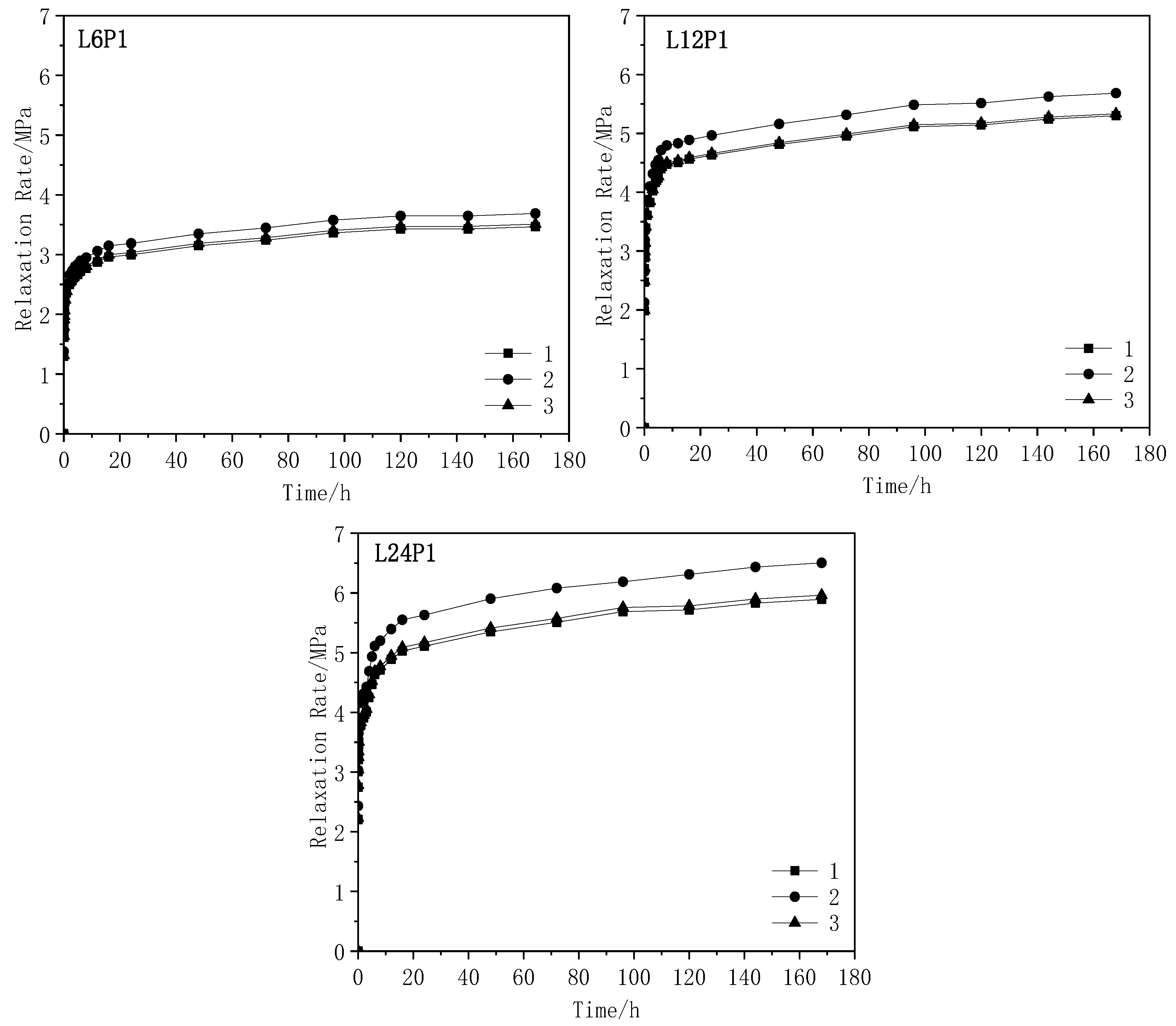
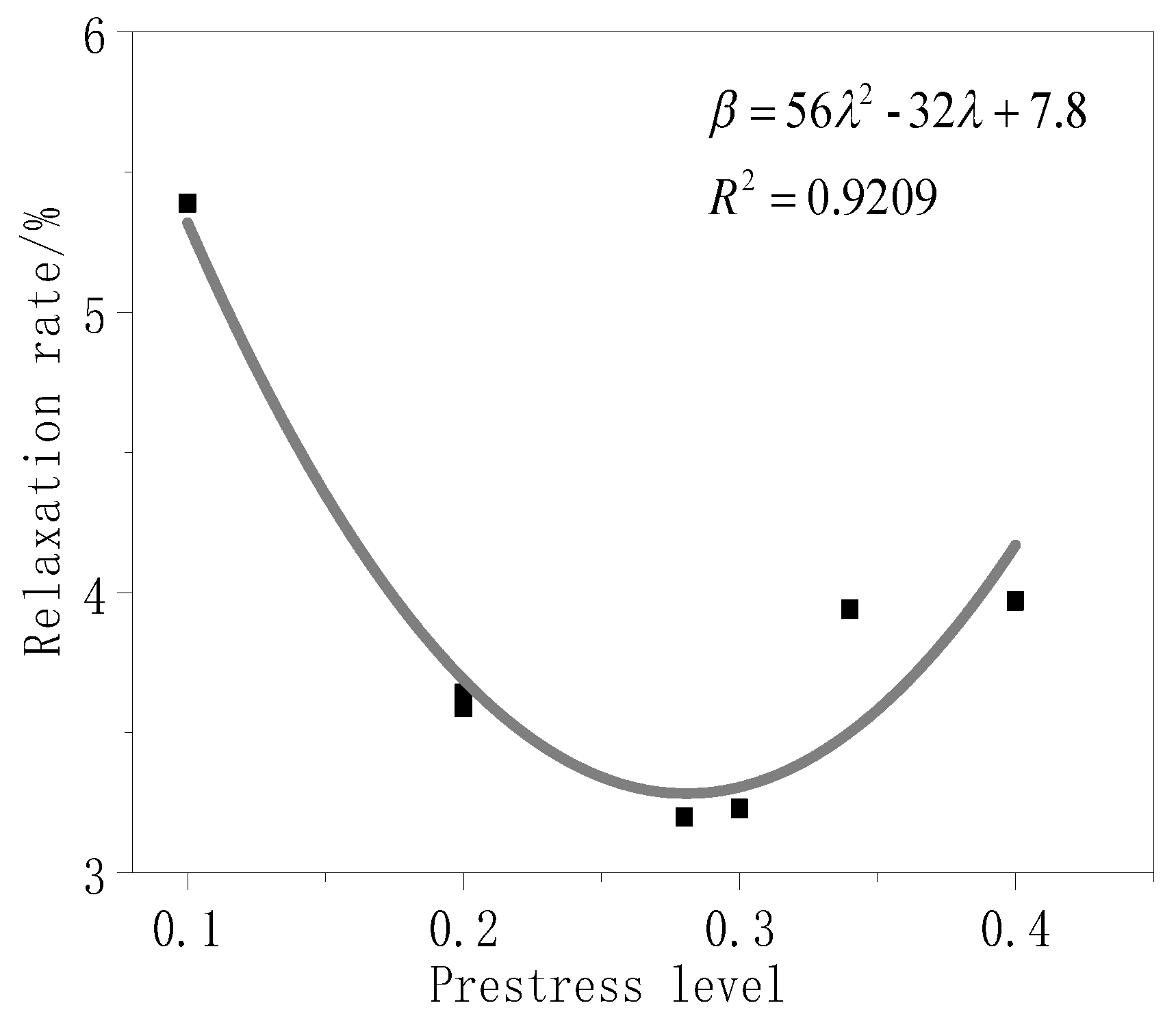
| No. | Specimen No. | L/mm | λ | No. | Specimen No. | L/mm | λ |
|---|---|---|---|---|---|---|---|
| I | L6P1 | 600 | 0.1 | IV | GL6P1 | 600 | 0.1 |
| L6P2 | 600 | 0.2 | GL6P2 | 600 | 0.2 | ||
| L6P28 | 600 | 0.28 | GL6P28 | 600 | 0.28 | ||
| L6P34 | 600 | 0.34 | GL6P34 | 600 | 0.34 | ||
| II | L12P1 | 1200 | 0.1 | V | GL12P1 | 1200 | 0.1 |
| L12P2 | 1200 | 0.2 | GL12P2 | 1200 | 0.2 | ||
| L12P28 | 1200 | 0.28 | GL12P28 | 1200 | 0.28 | ||
| L12P34 | 1200 | 0.34 | GL12P34 | 1200 | 0.34 | ||
| III | L24P1 | 2400 | 0.1 | VI | GL24P1 | 2400 | 0.1 |
| L24P2 | 2400 | 0.2 | GL24P2 | 2400 | 0.2 | ||
| L24P28 | 2400 | 0.3 | GL24P28 | 2400 | 0.3 | ||
| L24P34 | 2400 | 0.34 | GL24P34 | 2400 | 0.34 |
| Material Category | fy/MPa | E/MPa | fc/MPa |
|---|---|---|---|
| CFRP (sole fabric) | 3634 | 2.38 × 105 | - |
| Dip adhesive | 58 | 2584 | 78 |
| Specimen No. | Specimen No. | ||||
|---|---|---|---|---|---|
| L6P1 | 0.02 | 8.03 | GL6P1 | 0.02 | 8.03 |
| L6P2 | 0.03 | 12.05 | GL6P2 | 0.03 | 12.05 |
| L6P28 | 0.043 | 17.27 | GL6P28 | 0.04 | 16.67 |
| L6P34 | 0.06 | 24.1 | GL6P34 | 0.055 | 22.09 |
| L12P1 | 0.024 | 4.82 | GL12P1 | 0.024 | 4.82 |
| L12P2 | 0.033 | 6.62 | GL12P2 | 0.033 | 6.62 |
| L12P28 | 0.039 | 7.83 | GL12P28 | 0.048 | 9.64 |
| L12P34 | 0.052 | 10.44 | GL12P34 | 0.046 | 9.24 |
| L24P1 | 0.026 | 2.61 | GL24P1 | 0.026 | 2.61 |
| L24P2 | 0.038 | 3.81 | GL24P2 | 0.035 | 3.51 |
| L24P28 | 0.036 | 3.62 | GL24P28 | 0.033 | 3.31 |
| L24P34 | 0.058 | 5.82 | GL24P34 | 0.052 | 5.22 |
| Specimen No. | /MPa | /MPa | /% | /MPa | ||||
|---|---|---|---|---|---|---|---|---|
| L6P1 | 381.26 | 11.70 | 86.45 | 13.13 | 97.02 | 13.53 | 367.73 | 3.54 |
| L6P2 | 690.28 | 15.39 | 86.45 | 17.02 | 95.58 | 17.80 | 672.20 | 2.58 |
| L6P28 | 927.56 | 16.21 | 87.45 | 17.91 | 96.58 | 18.54 | 908.46 | 2.00 |
| L6P34 | 1161.39 | 26.17 | 86.45 | 29.01 | 95.73 | 30.30 | 1130.70 | 2.61 |
| L12P1 | 385.65 | 18.19 | 87.35 | 20.09 | 96.50 | 20.82 | 364.83 | 5.39 |
| L12P2 | 670.87 | 21.01 | 87.35 | 23.23 | 96.58 | 24.05 | 645.95 | 3.59 |
| L12P28 | 967.79 | 27.34 | 88.35 | 30.13 | 97.38 | 30.94 | 936.06 | 3.20 |
| L12P34 | 1161.85 | 39.45 | 86.24 | 44.14 | 96.50 | 45.74 | 1115.26 | 3.94 |
| L24P1 | 395.24 | 20.52 | 84.98 | 23.71 | 98.23 | 24.14 | 371.10 | 6.10 |
| L24P2 | 669.89 | 23.20 | 85.43 | 26.68 | 98.24 | 27.16 | 641.84 | 4.06 |
| L24P28 | 999.15 | 33.72 | 88.35 | 36.93 | 96.78 | 38.16 | 960.84 | 3.82 |
| L24P34 | 1161.26 | 47.07 | 85.35 | 53.85 | 97.64 | 55.15 | 1105.85 | 4.75 |
| GL6P1 | 386.32 | 12.53 | 94.59 | 12.99 | 98.06 | 13.25 | 373.07 | 3.43 |
| GL6P2 | 708.67 | 16.76 | 95.10 | 17.26 | 97.90 | 17.62 | 690.37 | 2.48 |
| GL6P28 | 935.76 | 17.09 | 95.20 | 17.47 | 97.36 | 17.95 | 917.04 | 1.92 |
| GL6P34 | 1186.89 | 28.17 | 94.63 | 28.69 | 96.38 | 29.76 | 1156.23 | 2.51 |
| GL12P1 | 396.48 | 18.77 | 93.00 | 19.79 | 98.06 | 20.19 | 376.29 | 5.17 |
| GL12P2 | 700.00 | 22.79 | 94.90 | 23.69 | 98.66 | 24.01 | 675.99 | 3.43 |
| GL12P28 | 980.90 | 28.43 | 94.82 | 29.45 | 98.23 | 29.98 | 950.01 | 3.06 |
| GL12P34 | 1190.37 | 42.56 | 95.38 | 43.45 | 97.38 | 44.62 | 1145.37 | 3.75 |
| GL24P1 | 397.65 | 21.67 | 94.60 | 22.46 | 98.06 | 22.90 | 374.75 | 5.76 |
| GL24P2 | 702.00 | 25.53 | 95.20 | 26.11 | 97.36 | 26.82 | 675.18 | 3.82 |
| GL24P28 | 1020.78 | 34.81 | 94.82 | 36.07 | 98.23 | 36.72 | 983.28 | 3.60 |
| GL24P34 | 1200.23 | 51.32 | 95.68 | 52.50 | 97.88 | 53.64 | 1146.36 | 4.47 |
| Specimen No. | Specimen No. | |||
|---|---|---|---|---|
| L6P1 | 3.54 | GL6P1 | 3.43 | 3.21 |
| L6P2 | 2.58 | GL6P2 | 2.48 | 4.03 |
| L6P28 | 2.00 | GL6P28 | 1.92 | 4.17 |
| L6P34 | 2.61 | GL6P34 | 2.51 | 3.98 |
| L12P1 | 5.39 | GL12P1 | 5.17 | 4.26 |
| L12P2 | 3.59 | GL12P2 | 3.43 | 4.67 |
| L12P28 | 3.20 | GL12P28 | 3.06 | 4.58 |
| L12P34 | 3.94 | GL12P34 | 3.75 | 5.07 |
| L24P1 | 6.10 | GL24P1 | 5.76 | 5.90 |
| L24P2 | 4.06 | GL24P2 | 3.82 | 6.28 |
| L24P28 | 3.82 | GL24P28 | 3.60 | 6.11 |
| L24P34 | 4.75 | GL24P34 | 4.47 | 6.26 |
| Strain Gauge No. | L6P1 | L12P1 | L24P1 |
|---|---|---|---|
| 1 | 390.42 | 392.83 | 409.7 |
| 2 | 367.04 | - | - |
| 3 | 385.6 | 366.32 | 371.14 |
| 5 | - | 390.42 | |
| 6 | - | - | 404.88 |
| 0.1 | 5.39 | - |
| 0.2 | 3.59 | 3.64 |
| 0.28 | 3.20 | - |
| 0.3 | - | 3.23 |
| 0.34 | 3.94 | - |
| 0.4 | - | 3.97 |
| Specimen No. | Specimen No. | ||||||
|---|---|---|---|---|---|---|---|
| L6P1 | 3.25 | 3.54 | 0.92 | GL6P1 | 3.38 | 3.43 | 0.99 |
| L6P2 | 2.58 | 2.24 | 1.15 | GL6P2 | 2.38 | 2.48 | 0.96 |
| L6P28 | 2 | 2.04 | 0.98 | GL6P28 | 2.12 | 1.92 | 1.10 |
| L6P34 | 2.61 | 2.48 | 1.05 | GL6P34 | 2.22 | 2.51 | 0.89 |
| L12P1 | 5.16 | 5.39 | 0.96 | GL12P1 | 5.40 | 5.17 | 1.05 |
| L12P2 | 3.59 | 3.64 | 0.99 | GL12P2 | 3.81 | 3.43 | 1.11 |
| L12P28 | 3.2 | 3.23 | 0.99 | GL12P28 | 3.38 | 3.06 | 1.11 |
| L12P34 | 3.94 | 3.56 | 1.11 | GL12P34 | 3.55 | 3.75 | 0.95 |
| L24P1 | 5.93 | 6.10 | 0.97 | GL24P1 | 6.30 | 5.76 | 1.09 |
| L24P2 | 4.06 | 4.19 | 0.97 | GL24P2 | 4.44 | 3.82 | 1.16 |
| L24P28 | 3.82 | 3.73 | 1.02 | GL24P28 | 3.94 | 3.6 | 1.10 |
| L24P34 | 4.75 | 4.24 | 1.12 | GL24P34 | 4.14 | 4.47 | 0.93 |
| AV | 1.01 | AV | 1.03 | ||||
| SD | 0.077 | SD | 0.094 | ||||
| COV | 0.075 | COV | 0.091 | ||||
| Author | Specimen No. | Time/h | ||||
|---|---|---|---|---|---|---|
| Wang [25] | BPC-30-1 | 0.36 | 2500 | 3.9 | 3.6 | 0.92 |
| BPC-40-1 | 0.40 | 3.6 | 4.0 | 1.11 | ||
| BPC-30-2 | 0.28 | 3.7 | 3.3 | 0.89 | ||
| Huang [19] | 1 | 0.20 | 480 | 4.25 | 3.82 | 0.90 |
| 2 | 0.20 | 3.85 | 0.99 | |||
| 3 | 0.2 | 4.21 | 0.91 | |||
| 4 | 0.30 | 3.32 | 3.4 | 1.02 | ||
| 5 | 0.30 | 3.41 | 1.00 | |||
| Li [28] | 1 | 0.45 | 168 | 5.364 | 4.741 | 0.88 |
| 2 | 0.45 | 4.772 | 0.99 | |||
| AV | 0.96 | |||||
| SD | 0.069 | |||||
| COV | 0.072 | |||||
© 2020 by the authors. Licensee MDPI, Basel, Switzerland. This article is an open access article distributed under the terms and conditions of the Creative Commons Attribution (CC BY) license (http://creativecommons.org/licenses/by/4.0/).
Share and Cite
Wang, Q.; Song, H.-L.; Lu, C.-L.; Zhu, W.-X.; Huang, J.-Z. Experimental Study of the Relaxation Properties of Carbon Fiber Cloth. Materials 2020, 13, 3603. https://doi.org/10.3390/ma13163603
Wang Q, Song H-L, Lu C-L, Zhu W-X, Huang J-Z. Experimental Study of the Relaxation Properties of Carbon Fiber Cloth. Materials. 2020; 13(16):3603. https://doi.org/10.3390/ma13163603
Chicago/Turabian StyleWang, Qiang, Hua-Lin Song, Chun-Ling Lu, Wan-Xu Zhu, and Jia-Zhu Huang. 2020. "Experimental Study of the Relaxation Properties of Carbon Fiber Cloth" Materials 13, no. 16: 3603. https://doi.org/10.3390/ma13163603
APA StyleWang, Q., Song, H.-L., Lu, C.-L., Zhu, W.-X., & Huang, J.-Z. (2020). Experimental Study of the Relaxation Properties of Carbon Fiber Cloth. Materials, 13(16), 3603. https://doi.org/10.3390/ma13163603





